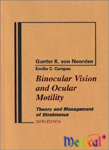I. PHYSIOLOGY OF THE SENSORIMOTOR COORDINATION OF THE EYES
General Introduction
Binocular Vision and Space Perception
Summary of the Gross Anatomy of the Extraocular Muscles
Physiology of the Ocular Movements
The Near Vision Complex
Histology and Physiology of the Extraocular Muscles
Visual Acuity, Geometric Optical Effects of Spectacles,
Aniseikonia
II. INTRODUCTION TO NEUROMUSCULAR ANOMALIES OF THE EYES
Classification of Neuromuscular Anomalies of the Eyes
Etiology of Heterophoria and Heterotropia
Symptoms in Heterophoria and Heterotropia and Psychological
Effects of Strabismus
Examination of Patient I - Preliminaries
Examination of Patient II - Motor Signs in Heterophoria and
Heterotropia
Examination of Patient III - Sensory Signs, Symptoms, and
Binocular Adaptations in Strabismus
Examination of Patient IV - Amblyopia
Examination of Patient V - Depth Perception
III. CLINICAL CHARACTERISTICS OF NEUROMUSCULAR ANOMALIES OF THE
EYES
Esodeviations
Exodeviations
Cyclovertical Deviations
A and V Patterns
Paralytic Strabismus
Special Forms of Strabismus
Anomalies of Convergence and Divergence
Nystagmus
IV. PRINCIPLES OF THERAPY
Principles of Nonsurgical Treatment
Chemodenervation of Extraocular Muscles - Botulinum Toxin
Principles of Surgical Treatment


